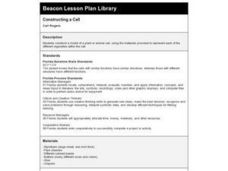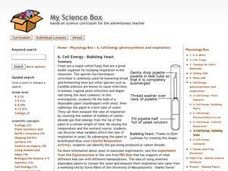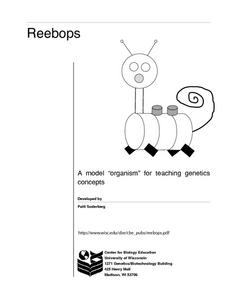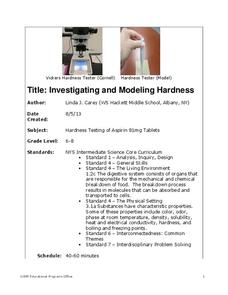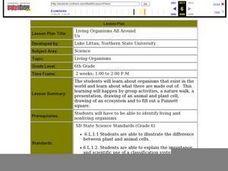Curated OER
Constructing a Cell
Third graders, in groups, make a model of a plant or animal cells and represent each of the organelles in the cell.
Curated OER
How HIV Infects Cells
In this how HIV infects cells worksheet, students read the given information about how HIV infects cells. Students explain the role of various structures in HIV infection. Students design a drug that might slow the rate of cellular...
Curated OER
Community Cell
Students explore parts and functions of the cell, and create models of assigned organelles.
Curated OER
Cell Size and Division or How Big Would You Want To Be if You Were a Cell?
Learners investigate why cells divide. In this cell size lesson plan, students observe how far a solution travels into 3 different size model cells of agar. They answer questions about the most effect movement of "nutrients" into the...
Curated OER
Satellites and Solar Cells
In this satellite and solar cells instructional activity, students determine the electrical power generated by the solar cells on the IMAGE satellite. Students solve 3 problems including finding the usable area of the satellite,...
Curated OER
Cells All Around
Students measure the size of an epithelial cell and to estimate the number of epithelial cells in a given area of the body. After watching a video on cells, student groups perform an experiment using a microscope to view some of their...
Curated OER
Cell Energy - Bubbling Yeast
Students identify that yeast are a single celled fungi that are a great model organism for studying respiration in the classroom. They also fill the bulb of a disposable pipet (eyedropper) with yeast, then submerge the pipet in a test...
Curated OER
Review of Cell Organelles
In this cell organelles worksheet, students read the structure and function of different plant and animal cell organelles to determine what organelle is being described. Students write in the 15 organelles into a chart.
Curated OER
Memorable Cell Membrane
Young scholars investigate the components of a cell membrane. In this cell membrane lesson plan, students build a cell membrane model using toothpicks and candy to represent the parts of the membrane including the phospholipid bilayer...
Alabama Learning Exchange
Edible Cell
Students identify cell parts and their function. For this animal cell lesson, students view a video clip and discuss cell components. Students create an edible replica of an animal cell using food items.
Curated OER
Cell City Analogy
In this cell analogy learning exercise, students are given a story about a city that produced widgets. They compare this to a cell and identify the parts of the cell that are analogous to the parts of the city. They then create their own...
Curated OER
Cosmic Rays and Solar Cells
In this cosmic rays and solar cells activity, students read about how cosmic rays damage the electrical output of solar cells over time on satellites. Students use a graph of the solar power output compared to the year for the SOHO...
Curated OER
The Building Blocks of Life: Cell Building
Young scholars view a short video from www.unitedstreaming.com. They then construct parts of a cell by building a model of an animal and plant cell using regular household materials.
Curated OER
Reebops a Model "Organism" for Teaching Genetics Concepts
Reebops are cute, marshmallow-based creatures that can be used to teach inheritance. Beginning biologists draw strips of paper that represent chromosomes from two envelopes, one for the father, and one for the mother. Each parent...
Curated OER
Solar Cell Simulation
Pupils study photovoltaic technology. In this photovoltaic technology activity, students simulate a photovoltaic system. Pupils discuss how to simulate a cloudy day.
Cornell University
Investigating and Modeling Hardness
Model hardness testing with a self-designed hardness test. Young scholars rate the hardness of different types of aspirin using the Vicker's Hardness scale. They then relate hardness to the solubility of each aspirin tablet.
Curated OER
Eukaryotic Animal Cell, Candy Cell Model: Science
Students review the parts of the eukaryotic animal cell and construct a model using various types of candy.
Curated OER
Cell Project
Students view a video of various cells and organelles. They create a 3-dimensional representation of a cell (complete with organelles) out of everyday objects that function in the same way as the various parts of the cell.
Baylor College
What Is a Neuron?
Your class won't get on your nerves while doing this modeling activity! After teaching the structure and function of a neuron using the included diagrams, give individuals some clay and chenille stems so that they can make their own...
Curated OER
Series or Parallel?
Emerging electricians extend mental models of light bulbs and resistors in series and or in parallel circuits to include the connection of photovoltaic cells in arrays. They investigate open circuits, using a DC voltmeter, a light...
Curated OER
DNA, the Awesome Thread of Life
Students examine how traits are passed to offspring. In this genetic reproduction lesson students develop a model of dna and learn about its structure, replication and function.
Biology Junction
Cellular Structure
The human body contains more than 200 types of cells, and plants contain many other unique types of cells. While a huge variety of cells exist, they appear to have very similar structures. A detailed presentation describes the structure...
Curated OER
Living Organisms All Around Us
Sixth graders study organisms that exist in the world and what they are made up of. They participate in a nature walk, a presentation, a drawing of an animal and plant cell, draw a ecosystem, and fill out a Punnett square.
Concord Consortium
Modeling Translation
An mRNA sequences make proteins, the most common molecules in cells. Young scientists observe translation of mRNA on ribosomes. They view them forming amino acids. Finally, the amino acids curl into proteins.
Other popular searches
- 3d Cell Model
- Cell Model Styrofoam
- Plant Cell Model
- 3d Plant Cell Model
- Construct a Cell Model
- Candy Cell Model
- Paramecium 3d Cell Model
- Modeling Cell Structures
- Mitochondria Cell Model
- Model of a Cell
- Building a Model Cell
- Edible Cell Models


